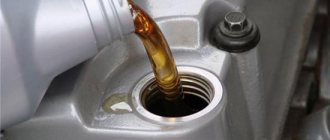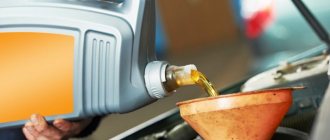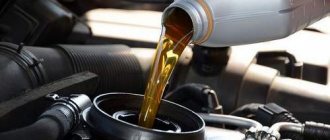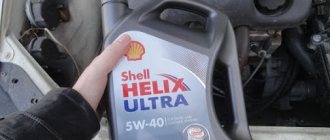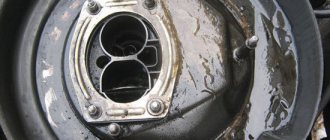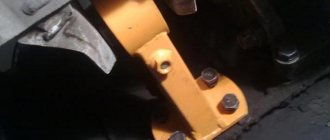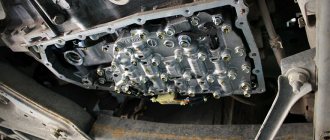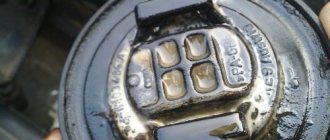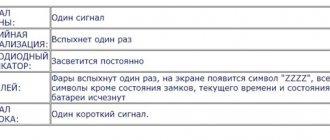Often car owners are faced with such a common problem as the engine eating up oil. Most often, such malfunctions are accompanied by the appearance of characteristic bluish smoke from the exhaust pipe. But what to do if the oil leaves the engine, and the characteristic black or bluish smoke is completely absent. What possible leak locations should you pay attention to in this case and how to restore the car by solving the existing problems.
The engine oil consumption is increased, but the engine does not smoke: the main reasons
To understand why the engine eats oil but does not smoke, you need to study the possible causes of increased lubricant consumption.
First of all, if there is no oil smoke, but oil consumption is higher than normal, at first glance it may seem that there are no problems with the cylinder-piston group.
On the one hand, this is a big plus, since there is no urgent need to repair the engine. Moreover, if the oil goes somewhere, the power plant still needs diagnostics. Let's figure it out.
As a rule, drivers often attribute increased lubricant consumption without obvious engine smoking to poor oil quality. Some people also tend to believe that after driving at high speeds, an increase in consumption is completely normal.
Currently reading:
Let us immediately note that in both the first and second cases certain losses are allowed, but if you have to add oil in liters every 2-3 thousand km. mileage, then it has nothing to do with the quality of the lubricant and the operating characteristics of the car.
In other words, there are problems that need to be fixed. Most often, the main cause is an oil leak. At the same time, there is not always an obvious leak, when after parking you can notice drops of lubricant under the car. For this reason, when parking, you need to place a sheet of white cardboard under the car.
The detection of yellowish spots on the sheet will indicate that engine oil or transmission oil is leaking in a car with a manual transmission, while reddish spots will indicate lubricant leaks from the automatic transmission or power steering. Also, the check may not yield anything, that is, the sheet will turn out to be blank.
In this case, a leak cannot be ruled out either, but determining the location of the leak will be even more difficult. So, whether there are stains under the car or not, we move on to the next stage, which involves a visual inspection of the engine compartment and engine compartment.
You should immediately inspect the valve cover gasket, as this problem is very common. If oil leaks are visible on the outside of the engine, then the problem is obvious. The solution is to replace the valve cover gasket or install fresh valve cover sealant.
In the case where no drips are visible from under the cover, you need to go under the car and inspect the pan gasket. The specified gasket may be worn. Also, during operation, one should not exclude the possibility of impacts on the pan, which breaks the tightness of the connection and leads to lubricant leaks.
The next element to check are the seals. Both the front and rear crankshaft oil seals can leak. Camshaft seals also often leak.
At the same time, the condition of the seals itself is difficult to determine during external examination. A sure sign of an oil leak is “fogging” of the oil seals, heavy oiling at the place of their installation, etc. At the same time, it is necessary to change the engine seals faster. The fact is that in addition to loss of lubricant, oil can get on other parts and components.
For example, if the timing belt is equipped with a belt and not a chain, then the lubricant can soften the rubber from which the belt is made, which leads to its breakage with all the ensuing consequences.
By the way, on many internal combustion engines the oil pressure sensor is located above the oil filter. Visually, a sensor leak can be mistaken for leaks from under the oil filter housing, but replacing the oil filter with a new one does nothing. For this reason, before deciding to replace the filter, you need to make sure that the sensor is working properly.
The camshaft plug, which can be found on engines with two camshafts or internal combustion engines with a single camshaft that do not have a distributor, deserves special attention during diagnostics.
In this case, oil leaks through the O-ring, and the entire plug requires replacement. This element can be either plastic or made of rubber. In practice, rubber plugs are more durable.
The only thing is that if the plastic plug can be changed quickly and easily, then the rubber plug requires more precise installation in place in order to get rid of leaks and achieve the desired tightness.
If the engine is equipped with a distributor, oil may leak through the O-ring. Replacing such a ring is not difficult, but then you will need to set the OZ.
A more difficult case is when oil gets into the distributor. The main symptom is a characteristic cracking sound (bearing cracks), as well as malfunctions of the distributor. In this case, the distributor will require disassembly, cleaning and replacement of the bearing along with the oil seal.
Solutions to possible problems
The car owner, regardless of the reason for the loss of engine oil, should immediately contact specialized workshops as soon as such problems appear. In some cases, the nature of the malfunction can be determined by just a visual inspection of the motor, while in other cases it is necessary to open the engine, and such diagnostics will already have a high cost.
It is much worse if the cause of loss of engine oil is problems with the cylinder head. In such a case, it is necessary to bore the cover or completely change it, and the cost of such spare parts will be comparable to the cost of a major engine overhaul. Similar problems occur when the engine overheats and prolonged operation at elevated temperatures.
The car owner needs to remember that one should not skimp on diagnostics and quality of repairs. If the engine begins to lose oil, then such problems will not disappear on their own. The longer the car owner neglects such faults, the more expensive it will be to repair the car in the future.
For what reasons does the engine eat more oil than it should?
To understand why the engine began to consume more oil, you need to study the factors leading to this situation.
Engine overheating
One of the reasons for increased engine oil consumption is too high a temperature in the cylinders. This happens when the ignition timing is broken; if we are talking about a diesel engine, then the fuel is injected at the wrong time. If you use gasoline that is not intended for a particular engine, the temperature will also become too high due to detonation.
If the engine overheats, the oil seals are damaged and scuff marks appear on the cylinder walls. Often one incident of overheating is not enough to cause damage. Of course, if this did not last long and the coolant was not brought to a boil.
Usually, even a couple of such cases pass without harm to the motor. But with several overheats, the material of the caps becomes rough. The required contact between them and the valves is not ensured. The result is that oil appears in the intake manifold. Then it enters the cylinders, and smoke can be seen in the exhaust gases.
Using oils that are not suitable for viscosity
Cuffs may lose their original properties if incorrectly selected additives are used. Oil consumption will also be increased in the case when, instead of the one provided for a particular car, the first available one is filled.
It’s good if it matches the required viscosity, or the parameters are close to it. If this is not the case, then increased consumption cannot be avoided.
Engines that were developed in the 80s were designed to operate with viscous mineral water; as a result, thinner synthetic compounds cause leaks.
Among other things, a unit designed for mineral oil begins to smoke when filled with synthetic oil. Modern engines run on synthetics, and the use of mineral compounds will lead to oil getting into the combustion chamber and repairs even after a relatively short mileage.
Wear of rings, valve stem seals
The next reason for increased oil consumption is wear of the piston rings or oil seals, or both. In such cases, the oil ends up in the combustion chamber, as evidenced by the smoke in the exhaust gases.
Oil seals are special oil seals in the engine. They are made from special materials that can withstand elevated temperatures. Due to severe wear, the oil seal loses its original properties.
Wear of these parts occurs due to the high mileage of the car. That is, they simply wear out. They are also damaged when the engine overheats. The reason is the wrong choice of oil type or the discrepancy between its viscosity and the required level.
Oil additives have a negative effect on rings and caps if they are not selected correctly. In addition, the reasons include too high crankshaft speeds, repeated cold starts of the engine, and regular operation of the engine at maximum power.
The easiest way to eliminate the cause is to replace the valve stem seals. This operation does not require significant costs. To replace it, you must remove the cylinder head. This cause of oil burning can be corrected at minimal cost. Replacing piston rings is more difficult. Almost complete disassembly of the engine is required.
Drying of cuffs and seals
The bolts securing the engine parts need to be tightened from time to time. Under the influence of temperatures and incorrectly selected additives, the gaskets begin to shrink.
Oil leakage from the engine crankcase can also occur when the seals wear out. Seals and seals wear out over time. Gaskets may not provide a good seal due to loose bolts holding the trim parts to the engine.
If, during repairs, the crankshaft oil seals are installed with minimal distortion, this also causes an oil leak.
Crankcase ventilation system
High oil consumption also occurs when the PVC valve is faulty or the crankcase ventilation is impaired. Gases produced during fuel combustion pass between the surfaces of the cylinder walls and the piston rings. The pressure in the crankcase increases.
If the valve does not function properly, high pressure causes it to entrain oil and pass through the seals.
The same effect occurs when ventilation ducts are clogged. If in both cases all this continues for a long time, then even after the malfunction is eliminated, oil will leak through the seals.
Hidden places
Hidden places imply a leak that is not visible during simple inspection. To identify them, pay attention to other signs. Such options can confuse inexperienced car owners who are unable to understand why the engine eats a lot, does not smoke, and begins the wrong search for solutions. What needs to be done and how to check hidden places.
Cylinder head gasket
The main channel for lubrication of cylinder head parts passes through it. Breaking the gasket seal in this place will allow lubricant to enter the cooling system.
An inexperienced driver cannot detect such a malfunction. Not finding external traces of oil, he does not pay attention to the fact that the car eats a lot of motor lubricant and stops searching, thereby smoothly leading the power unit to failure and subsequent major repairs.
Crankcase ventilation
It plays a very important role in the correct operation of the motor.
When the ventilation is clogged, engine lubricant is released into the intake manifold or into the air filter housing.
This causes engine malfunction: characteristic uneven speed and loss of power. If there is an abundance of lubricant entering the intake manifold, it can interfere with attempts to start the engine. This malfunction cannot be detected by external inspection; to do this, you will have to remove the air filter cover, and only then will it be possible to understand the reasons why the power unit eats a lot of lubricant and does not smoke.
Coking of piston rings
It also promotes excessive consumption of lubricating fluid. The pollution enters the combustion chamber and begins to burn out little by little. At the same time, the engine begins to eat a lot of oil, emitting a subtle bluish smoke from the exhaust pipe, which often goes unnoticed. To eliminate the malfunction, the engine must be completely disassembled and the piston rings replaced.
Spark plug seals
Often, 16-valve powertrains allow lubricant to leak through the spark plug seals, which are located vertically in the valve cover. Lubricating fluid accumulates in the spark plug seats and is not visible during visual inspection. It gradually burns out from heated parts and leaves no traces.
The presence of a turbine in the power unit
It can contribute to increased consumption of engine lubricant through leaky connections. It will flow either outside or inside the intake manifold. This is also not visible to the naked eye, and if you don’t know, these traces will not be found.
Why does the engine start to eat oil intensively?
We should start with the fact that among internal combustion engines there is not a single one that does not consume oil during operation. This circumstance is inherent in the principle of their operation and motorists just have to put up with it. Even an engine installed in a car that has just left the showroom will consume a small amount of oil. But as the vehicle’s mileage increases, the oil consumption parameter will only increase. A new engine in a standard city car for a range of seven thousand kilometers on average consumes no more than 100 grams of lubricant.
The nature of excessive oil consumption by the engine can be determined by the intensity of the problem. The power unit can “eat” lubricant:
- in small volumes, slightly exceeding the norm specified by the manufacturer;
- in volumes significantly exceeding the norm;
- with enviable consistency and in the same quantity;
- periods: consumption will either be within the normal range or exceed it.
Tags
oil consumption increases.oil level gradually blue oil smokeoil consumption if oil smokeoil consumption is higher oil quality.if oil is oil leak.motor oil or engine oil leakswhy is engine oil engine oil leaks.engine oil leaks.engine oil consumptionloss of engine lubrication.poisons engine oil.engine oil consumptionunder engine engine oil consumption compartmentif the oil is in the engine oil or lubricant oil can the engine oil leaks out replacing the oil filter in case the oil leaks when the oil gets in. Engine tuning Engine tuning The engine takes the engine smoke the engine smokes.
article or transmission
Deterioration of the valve stem seals, wear of the liners
Look at the operation of the power unit at idle speed. If the caps are worn out, the car eats a lot of oil. At the same time, but at idle it does not smoke or produces a small amount of smoke. If large clouds of blue smoke appear when you press the accelerator pedal hard, this indicates wear on the caps.
In most cases, excessive consumption of engine mixture through worn caps does not occur; less than 500 ml of oil per 1 thousand km must be added. If oil consumption increases, the piston rings need to be replaced.
The deterioration of the condition of the caps is also indicated by velvety carbon deposits on the spark plugs and interruptions in engine operation. Such phenomena occur if the cuffs of the valve stem seals harden or if they are significantly worn, and they do not provide the required seal and lead to free flow of oil under the guide bushing, along the valve stem.
If, while checking the oil level in the engine, you notice shiny small particles in the engine fluid, this indicates wear on the liners.
Low quality motor lubricant
The reason that the engine consumes liquid may be low quality lubricants or the wrong type. For each car, including the Priora, there is a certain type of lubricant, but if it is selected incorrectly, consumption jumps sharply. For example, reduced viscosity can cause the piston rings to be unable to collect all the lubricant, causing it to settle on the cylinder walls and burn along with the fuel. As a result, combustion products either come out along with the exhaust in the form of bluish smoke, or settle in the form of soot on the spark plugs. The consequence may be coking of the rings, when the liquid settles in a thick layer on the engine components.
Gaskets
Is the engine burning oil? A common problem among cars such as VAZ, ZAZ, Moskvich, Volga. The use of second-class seals leads to their rapid wear. This provokes lubricant leaks, often hidden and difficult to detect.
To determine the malfunction, it is enough to carefully examine the surfaces of the power plant for the presence of wet spots, drips, and stains.
The cost of repair can vary greatly. It all depends on the location of the leak. For example, a valve cover gasket costs about 100 rubles, and can be changed in 5 minutes yourself. Deeper structures are treated at a service station by overhauling the engine, which is estimated to be 10–20 times more expensive.
Frenzy
Depending on the formula of the oil base and its basic quality, it may be more or less resistant to burning. Some oils are more prone to this.
The oil's carbon resistance depends on the quality of the additive in it, which is responsible for reducing the aging rate of the oil. The effect of aging is, in fact, the reason for its burnout.
It is worth understanding that at high speeds the lubricant will in any case begin to burn out. Thus, when traveling long distances, even without traces of smoke and soot (especially if the oil is of high quality, it leaves virtually no soot), oil is constantly lost.
Therefore, natural oil burnout, especially at high speeds, is not a big problem, since most motorists do not use their vehicles as often as a racing car.
Oil leak and its causes
In fact, there are not so many places for leaks, and most of them can be eliminated yourself.
Valve cover gasket
. The rubber can last for years - until it cracks over time or is removed for repairs and put back in place without sealant. Visually, a leak can be easily determined by oil drips on the outside of the engine. It is not very expensive, it can be changed within 10 minutes without visiting a service center. See How to Replace a Valve Cover Gasket.
Pan gasket
. The reasons for failure are wear and tear or physical trauma (for example, a blow to a pallet). Costs more than valve cover rubber, but still available. In most cases, it can be changed independently. The exception is some models of all-wheel drive SUVs, where you need to dismantle the gearbox or disassemble the gearbox.
Oil seals
. They can leak on both the crankshaft and the camshaft. You can’t judge their condition from the outside; you need to remember when the seals were last changed. If something happens, change it quickly, especially if the timing belt is belt driven and not chain driven: when oil gets onto the drive, it destroys the belt, and even after thorough wiping it will not last long. So it is strongly recommended to change the belt along with the seals.
Sensor
, namely, a switch that is triggered in case of emergency oil pressure values. Located above the filter on almost all models, the leak pattern is identical to the passage of liquid through the oil filter, and therefore the latter is often changed several times, and car owners scold manufacturers for a defective part. Tightening the sensor is absolutely ineffective; it must only be replaced. See the article “What oil pressure should be in the engine.”
Camshaft plug
. Found on 2-shaft B-series engines or single-shaft motors without a distributor. The o-ring begins to leak oil, but the entire plug needs to be replaced. It comes in plastic and rubber; the second is almost 10 times more expensive, but lasts much longer. Changing the plastic is a matter of minutes - it is simply picked out with a screwdriver, and a new plug is inserted in its place “by eye”. You will have to tinker with the rubber plug: it must be placed exactly.
On the distributor
The oil also poisons the seal. Changing the ring yourself is quite easy, the main thing is to set the ignition angle correctly. The situation can be complicated by oil flowing into the distributor. Symptoms: bearing cracking and a sharp, steady decrease in the performance of the part. Then the distributor must be disassembled, cleaned and the bearing with the seal replaced. Do-it-yourself repairs are not possible on all brands. Having found out why the engine eats oil but does not smoke, you need to try to eliminate the reasons as soon as possible, and some of them immediately.
Carry out decarbonization
If the cause of the oil burn is coked oil scraper rings, you can try, without disassembling the engine, to clean its parts from deposits using auto chemical products. In the early stages of loss of mobility by rings, it is possible to overcome the problem. Although it is, of course, impossible to guarantee a 100% result.
Of all the variety of decarbonizers, the best results are obtained by preparations that form foam in the cylinder. Due to their high penetrating power, they completely clean the combustion chamber.
Of all the variety of decarbonizers, the best results are obtained by preparations that form foam in the cylinder. Due to their high penetrating power, they completely clean the combustion chamber.
Where does the engine oil go if the car doesn't smoke?
To answer this question, you need to study in detail all the places in the engine through which oil can leak. For this, a white sheet of paper is best suited, which should be left under the engine overnight. The next morning, by the location of the spots on the surface of the paper, you can determine the place where the leak is coming from.
It should be remembered that you need to focus on the yellow spots. After all, if the oil spots are red, then this is most likely a lubricant leak from the automatic transmission or power steering.
If no stains are found on the sheet, you need to look for leaks in the most likely areas:
You need to carefully inspect the gasket under the valve cover. If there are clear oil streaks on the outer surface of the engine, then we can assume that the problem has been found. To solve the problem, you need to replace the gaskets under the valve covers or apply sealant.
Inspection of the pan gasket. This gasket may be worn. Solving the problem - replacing the gasket
In this case, it is important to purchase a gasket that, according to the catalog, fully matches a specific car. It is not recommended to install gaskets from another car, especially one with signs of wear.
Otherwise, the oil leak story may soon repeat itself.
Penetration of the pallet body when hitting a solid obstacle. In such a situation, you either need to replace the entire pan or, if the hole is not very large, you can try to weld it. You cannot use various cold welds to eliminate the leak. Indeed, under the influence of oil pressure, such temporary sealants do not provide a long-term effect and lead to repeated failure, during which a significant amount of oil is lost.
Oil seal failure
You need to immediately pay attention to the condition of the front oil seal mounted on the crankshaft. Oil seals located on the camshaft may also leak.
It is very difficult to visually verify that the seal is leaking. It must be remembered that the main sign of oil leakage through the oil seal may be their strong fogging and excessive oiling of the place where they are attached. If the cause of the leak is in the oil seal, it needs to be changed as quickly as possible, since engine oil can get through worn oil seals onto other engine parts.
Lubricant may be leaking from the oil pressure sensor. In this case, you need to carefully tighten the sensor using a wrench. Perhaps the sensor is not screwed in correctly at all and has a technical defect. As for sensors, to avoid a similar situation, you need to purchase only original sensors and under no circumstances run for a low price. Otherwise, you can buy a Chinese fake of low quality and a bunch of future problems.
Oil may be leaking through an oil filter that has a defective housing or is simply not tightened tightly enough. In many cars, the oil filter is installed at the bottom of the pan and can be damaged if it hits a hard object. Sometimes, the thread in the filter may simply be torn off, which prevents it from being tightened tightly enough.
The camshaft plug also deserves close attention, especially for engines with two camshafts and no distributor. Here, oil may leak out through the O-ring. In such a situation, you need to replace the plug itself. It can be made of plastic and rubber. Both options are quite acceptable, but the rubber plug will last longer. Although in practice, replacing the plastic plug is faster and easier.
Lubricant can leak through a damaged distributor o-ring. To eliminate the leak, you need to replace the O-ring and re-adjust the OZ.
It is much more difficult to eliminate a leak if oil gets into the distributor itself. The main sign of the presence of oil in the distributor is a specific crackling sound similar to the crackling sound of a bearing. To correct this situation, it is necessary to disassemble the distributor itself, clean it and replace the bearing with the seal.
Explicit places
Finding obvious places is quite simple; to do this, you need to wash the crankcase of the power unit, drive the car onto a lift or inspection hole and visually inspect the oil traces. Let's look at the most likely leak locations.
Valve cover gasket
It has a fairly large area and loses its elasticity over time. Traces can be found without any problems, you just need to carefully examine it. It may well begin to leak through it. The malfunction is eliminated by replacing the old seal with a new one. After replacement, the engine will no longer consume a lot of oil.
Camshaft seals
They have increased wear due to the speed of the camshafts. Thus, they develop a sealing surface and lose the tightness of the connection. Characteristic marks are also revealed by careful inspection. Because of this, the engine eats a lot of lubricating fluid. The problem is solved by replacing old seals with new ones.
Front and rear crankshaft oil seals
They are also subject to increased load and lose their tightness over time. You can check them by simply inspecting the front and rear parts of the crankcase of the power unit, on which oil traces will be clearly visible. This may create the feeling that the car is eating a lot of lubricant. The malfunction is eliminated by replacing with new ones, but in order to change the rear oil seal, you will have to do a fairly large amount of work to remove the gearbox.
Engine oil pan gasket
It is one of the largest in terms of seal area and is subject to constant oil presence. Over time, it loses its sealing properties, which contributes to possible leakage. The problem is discovered by inspection. If you replace the gasket with a new one, the problem will disappear.
Front engine cover gasket
The part also loses its properties over time, and oil can leak through it. Here it’s worth looking more closely; often oil traces spread along the edges of the pan, and it seems that it is the pan that is leaking.
Filler cap
Through its rubber seal it can release lubricating fluid under pressure. The leak is fixed by installing a new filler cap.
All places of leakage are quite capable of creating among inexperienced drivers the opinion that the power unit has begun to eat a lot of oil and does not smoke. They should pay special attention to the presence of the required level of lubricating fluid and check the car components for leaks.
What to do if the engine smokes when cold
If, after a long period of inactivity, the machine smokes heavily, and after a while it stops, then the check must be performed according to the following algorithm:
- Estimate the mileage of the car's engine, and also remember what kind of engine oil is poured into the crankcase and how long ago it was changed. Accordingly, if the engine is worn out and low-viscosity oil is poured into it, then it makes sense to replace it with a thicker one. Along with changing the engine oil, do not forget to replace the oil filter, and it is advisable to use the original filter. If the oil is old and the engine has a high mileage, then before directly changing the oil, it is advisable to flush the oil system.
- The appearance of bluish or black smoke on a cold engine is a reason to check the compression and condition of the piston rings. If the compression is low, you need to find out the reason. In some cases, the cause can be eliminated by decarbonizing the rings. Along with decoking, it is also advisable to pour flushing oil into the engine for cleaning purposes, and then change the oil to a new one, but taking into account the viscosity according to the condition of the engine and its mileage. If there is consistently high oil consumption, then it makes sense to change the piston rings.
- Check the condition of the valve stem seals. This is a fairly common reason why a car smokes when cold. For domestic cars, the approximate mileage before the next replacement of caps is about 80 thousand kilometers. For foreign cars, taking into account the use of high-quality oil, this mileage can be two to three times longer.
- Perform a sensor check using a scan tool. If it shows an error in any of the nodes, then you should treat it more carefully and replace it.
- Check the oil level and condition. An increase in volume or a change in color may indicate the presence of antifreeze. If the level of one of the liquids decreases, you need to perform additional diagnostics - check the valve stem seals, rings, and cylinder head gasket.
For owners of diesel engines, in addition to the above recommendations, it is also advisable to perform several additional procedures.
- If, in addition to smoke after starting, the engine also “troubles”, then you need to check the condition of the fuel injectors. If you identify a faulty or contaminated injector, you must first clean it, and if this does not help, replace it with a new one.
- Check and, if necessary, clean the EGR.
- Check the operation of the high pressure pump, check valve and the fuel line as a whole for fuel leaks.
Conclusion
According to statistics, in approximately 90% of cases, the reason that a car smokes when cold is faulty valve stem seals. Therefore, first of all, you need to check their condition. After this, you need to check the condition of the piston rings, viscosity and general condition of the oil. It would not be superfluous to diagnose the control unit for errors. The fastest way to diagnose and find out the origin of the smoke is to use an ordinary sheet of white paper near the exhaust. By the traces and smell remaining on it, you can quickly determine what is entering the combustion chamber - liquid, fuel or oil.
Source
When there are no visible symptoms of a leak
- If you fill your engine with oil whose viscosity does not meet the manufacturer’s requirements, you can be sure that problems will manifest themselves sooner or later. The fact is that the automaker selects the right substance through lengthy tests. Essentially, it makes it easier for drivers to buy the right fluid and save money. If the lubricant is too viscous, the engine will have difficulty turning the crankshaft, experiencing severe overload. Overloading will cause the need to burn more fuel mixture, which means that savings in this case are not appropriate. If the film is too liquid, some of the elements, and maybe the entire system, will work without the proper level of protection. This is fraught with serious overheating of the system, rapid wear of working mechanisms and increased leakage of oil fluid.
- The engine consumes oil with an aggressive driving style. And the reason for this is not a violation of the tightness of the system or wear of operating mechanisms, but the expansion of metal elements when overheated. At the moment of a sharp start, the engine begins to actively pump oil through the system, but for this it requires more effort. Great efforts lead to sudden overheating of the elements and their subsequent expansion, and here it is already quite clear why the protective lubricant ends up in the combustion chamber.
When selecting the right automotive lubricant, always rely on the manufacturer’s recommendations. Under no circumstances should you pour liquid under the hood whose viscosity prohibits the use of the car manual.
Reasons why the engine consumes oil?
Valve seals very often cause increased engine oil consumption. Oil seals are installed on the valves of the gas distribution system. Unexpected phenomena are possible here. For example, a poorly warmed-up engine increases the likelihood of hardening of the cap seals significantly, and there is no need to talk about used engines. A “stiffened” cap will not provide a seal, therefore, oil will flow freely under the guide sleeve, along the valve stem. After this, the engine oil will either fly out along with the exhaust gases, or enter the combustion chamber and, burning, cover the spark plugs. The result is a velvety soot on the spark plugs and interruptions in engine operation.
Piston rings are the second most likely reason why an engine is burning oil. One piston usually has three rings, two compression rings on top, and one oil scraper ring underneath them. I hope you know what compression rings are for. With their help, the manufacturer reduces the gap between the piston and the cylinder wall, resulting in maximum efficiency of the transmitted energy for engine rotation. In order to reduce the friction that occurs between the compression rings and the cylinder walls, oil is supplied to them, the remains of which are removed by the oil scraper rings. Wear of these rings leads to the fact that some of the oil will remain on the walls, therefore, oil consumption will increase. As a result, one day you will miss several liters of engine oil and come to the conclusion that the engine is eating oil.
During its “life”, the motor undergoes a large number of heating and cooling cycles. At the same time, all engine parts are tested. Wear of piston rings or loss of elasticity, in addition to reducing compression, is also fraught with the occurrence of a phenomenon called flutter. This phenomenon has been little studied, but one thing is known for sure: when the engine is running, the ring can oscillate along the piston radius with a high frequency, or can repeatedly jump from one edge of the piston groove to the other. Due to such fluctuations, the engine consumes almost liters of oil; most often this malfunction manifests itself in the form of characteristic blue smoke from the exhaust.
Low quality motor oil, as well as oil that does not match the type of engine, also often causes the engine to start to take oil. This reason indirectly affects the previous malfunction. The fact is that each engine has its own oil; if it is chosen incorrectly, its consumption can increase significantly. Due to the fact that the oil is too liquid, the piston rings cannot “collect” it and it remains on the cylinder walls and, after the fuel-air mixture is ignited, it burns along with it. As a result, it either “flies out” with the exhaust, or is deposited in the combustion chamber or on spark plugs, but no matter how you look at it, the oil level will constantly decrease. Also, often the “wrong” oil is deposited in a thick oily layer on engine parts, this can lead to “sticking” or coking of the rings. If the rings are stuck, compression is lost in all engine cylinders.
There are other reasons why an engine takes oil, such as natural wear and tear. In this case, a comprehensive production of all engine parts occurs. As a result, oil is lost many times faster than during normal operation. Engine wear most often involves deformation of the cylinder walls as the engine continues to be used. An increased gap between rubbing surfaces, cracks and chips and scuffs on the cylinder walls, as well as burnt-out cylinder head gaskets and hardened oil seals lead to oil leakage and a drop in its level. Residues of oil burn out or are deposited on parts; it is quite difficult to predict what the consumption will be in this case, it all depends on the degree of wear and damage to the internal combustion engine.
In conclusion I would like to add...
You should also be aware of replacement cycles. Remember that timely replacement will save you from many problems, including such an unpleasant phenomenon as excessive consumption of engine oil. Also, do not forget to flush the engine in a timely manner using special flushing oils. Buy only high-quality motor oil from a trusted manufacturer, the one recommended by your dealer or the one specified in the owner’s manual for your car.
Other articles about DIY VAZ car repairs.
Defect in sealing components
Initially, the service life of all gaskets and seals in an internal combustion engine under normal conditions is calculated until the end of its service life. Many motorists begin to panic at the sight of an oil stain under their “iron friend,” and rightly so, although panic is not entirely appropriate here. The cause of oil leakage lies in damage to one of the sealing elements.
And here we can mention the harsh climate of Russia, the constant and rather sharp changes in temperature, which often cause the loss of elasticity of parts made from rubber. Parts and components lose their tightness and negative phenomena such as engine oil leaks appear.
However, here we can make a remark that the Russian automobile industry is obliged to provide for such breakdowns associated with climatic conditions and completely eliminate them. In reality, everything happens differently; it is domestic cars that suffer disaster first.
Malfunctions of the crankcase gas valve
In order for the piston rings to work correctly, the pressure of the crankcase gases must be maintained at a certain level, and this happens thanks to the bypass valve. If it fails, there is a loss of oil, since it is not properly removed from the piston rings. Thus, the lubricant goes into carbon monoxide. Due to improper operation of the valve, the oil seals begin to squeeze out, the gaskets become deformed as the pressure in the lubrication system increases.
Ways to eliminate oil starvation
How can engine oil starvation be dangerous? The consequences for the operation of the engine are quite dangerous and often lead to complex breakdowns of internal parts. What are the reasons that often lead to starvation? We will consider these and some other questions in this article.
Engine oil starvation has negative consequences. There may be almost no oil in the power unit, or it may be below normal (if it is not regularly monitored). This problem can be easily eliminated by finding its visible causes. Perhaps you just need to add oil to the desired level and that will be enough. Most often this is what happens in practice. You should also carefully visually inspect the engine for oil leakage. If a leak is detected, it is eliminated by tightening the bolts.
The most problematic situation occurs when the oil level in the power unit is within normal limits, and certain components do not come into contact with it. That is, it does not reach all the details. The reason may be that the oil has not been changed for a long time, or the channels are clogged. Good cleaning and rinsing solves the problem.
The consequences of starvation are quite varied, up to the failure of certain components of the power unit. One of the most common causes of fasting is untimely replacement. This leads to dirt accumulating in it, clogging the oil line. This in turn limits oil access to all engine parts.
The oil enters the lubrication system using a pump, then through the filter it reaches all engine components. The diameter of the oil line is five millimeters, and if there is little oil or it has not been changed for a long time, then the channels become clogged and clogged. Oil cannot push through blockages and oil starvation occurs.
Thus, it becomes clear that the oil should be changed regularly, otherwise, instead of protecting it, it begins to destroy the power unit from the inside.
Main causes of fasting
- Insufficient amount of oil in the power unit.
- Long absence of oil change.
- The oil filter is clogged.
- The wall of the oil receiver is clogged.
- The channels are clogged.
- The pressure reducing channel on the pump is broken.
If you do not look under the hood for a long time to check the oil level, then one day it will become so low that it will not reach the oil receiver and will stop flowing to many parts of the engine.
If it is not changed for a long time, then dirt will form in its mass, accumulating on the walls of the block. The oil needs to be changed on average once every 10 thousand kilometers.
The oil filter consists of a housing and a paper filter. Dirt clogs the filter, and its throughput gradually begins to decrease, and then disappears altogether. The oil pump has a pressure reducing valve that relieves pressure. If it jams, the pressure will drop, which will inevitably cause oil starvation.
The lubrication system of the power unit consists of channels. The crankshaft is the most vulnerable. It has oil channels that are narrow and easily clogged. This leads to oil starvation of the connecting rod bearings.
Today, many cars are equipped with low oil protection. This is a sound signal and a warning light. But the sensor reacts when there is a significant lack of oil in the engine. The crankshaft and camshaft will not seize, but the power unit will wear out a lot. To avoid this, you need to monitor the oil level in the engine, looking under the hood once a week. This way the motor will not starve and will last long enough.
Solving the performance problem
To prolong the performance of the power unit and maintain the integrity of parts and assemblies, you should rinse it thoroughly. The same must be done with the oil wire. Then immediately change the engine oil
When flushing, careful attention is paid to all parts of the pipeline. It can be thoroughly wiped with standard solvent
You can also clean the pipeline with wire. This is done very carefully so that it does not break off, clogging the passage channel. For washing, you can use diesel fuel or gasoline.
After the washing is completed, all spare parts are put in their “native” places. Then you can begin to clean the power unit from accumulated dirt. Fill in the flushing oil, turn on the engine and run for ten minutes at idle speed.
After which it is replaced with working oil. This is how the effects of fasting are negated. You should always remember that timely oil changes prevent engine oil starvation, the consequences of which are fraught with the problems described above. This also ensures that the engine and all its parts are kept clean and free from clogging. And this is the key to its high-quality and durable operation.
Source
How to determine the cause of increased oil consumption
To identify the causes of increased consumption, diagnose the following parameters:
- Exhaust color. Such diagnostics must be carried out by at least two people. The driver, by pressing the gas pedal or pulling out the throttle valve, increases the speed to about 2-3 thousand, and his assistant looks to see if the engine is smoking. Gray or bluish smoke indicates a problem with oil getting into the cylinders through the caps or a broken gasket. There are cases when the engine eats oil, but does not smoke. An exception may be diesel engines that produce black smoke when the gas pedal is pressed sharply, which disappears after the speed drops.
- Presence of leaks If oil stains appear under the engine of a parked car, urgent repairs are needed. A serviceable engine should not have any oil leaks or stains. If you notice a suspicious spot, you need to warm up the engine to operating temperature, periodically increasing the speed, or drive several kilometers, also alternately accelerating sharply. If the stain becomes wet and becomes larger, the problem is a malfunction of the crankcase ventilation system, poor tightening or a damaged gasket.
- Condition of the crankcase ventilation system. To do this, you need to unscrew the fastening clamps and remove the valve, then blow it out. If there is no problem, then the air will flow under low pressure and only in one direction. To prevent clogging with dirt, you need to remove and blow out all the hoses and check the pipes.
- Conditions of the cylinder head gasket. These actions are carried out after detecting bluish smoke in the exhaust gases. Even if the gasket itself does not have burnouts or visible damage, it could be deformed due to engine overheating, which does not have the best effect on its operation. This means that it is unsuitable for further use and needs to be replaced.
What should you keep in mind?
If the engine consumes a large amount of oil, but you do not have the opportunity to diagnose the car yourself, what should you do in this case? Take the car to an official representative. Only there will he receive proper help.
Now you know why the engine has oil. Timely diagnosis of the problem allows you to protect yourself from serious breakdowns in the future. In other words, if you find that the oil is leaving very quickly, immediately look for the reason for this. Regular topping up won't eliminate the leak, but it will put a significant dent in your pocket.
When operating vehicles with different types of engines (gasoline, diesel), car owners often encounter an increase in oil consumption. At the same time, it is well known that in case of problems with the CPG, engine smoke is usually added to lubricant consumption.
However, it also happens that the oil level gradually decreases, but there is no blue or bluish oil smoke from the exhaust pipe. In this article we will talk about why oil consumption may be increased, but the engine does not smoke.
